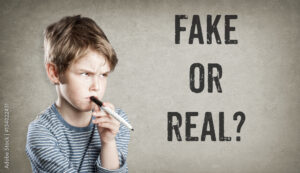 Mass media has created the opportunity for anyone online to potentially become a ‘News Reporter’. One cannot simply believe everything they read online. You can easily type your opinion into Google and many ‘articles’ will appear that support your opinion. However, it doesn’t mean they are all factual and they mostly only help to further deepen one’s biases. This combined with the advancement of technology, specifically DeepFakes, means we are no longer living in a society where “seeing is believing”. This makes it increasingly difficult to spot fake news stories. Even if we see or hear something on the internet, we still need to use critical thinking and not just blindly accept it for the truth. The problem lies in that a lot of the fake news and disinformation out there is being accepted as the truth, largely due to a lack of education around fake news, but also due to the fact that there is so much fake news being thrown at us constantly. This means that our critical thinking gets exhausted and we are more likely to let our guards down. This is why it is extremely important to educate both ourselves and our students in digital literacy in order to combat the spread of fake news. Once again, knowledge is key to combating disinformation!
Mass media has created the opportunity for anyone online to potentially become a ‘News Reporter’. One cannot simply believe everything they read online. You can easily type your opinion into Google and many ‘articles’ will appear that support your opinion. However, it doesn’t mean they are all factual and they mostly only help to further deepen one’s biases. This combined with the advancement of technology, specifically DeepFakes, means we are no longer living in a society where “seeing is believing”. This makes it increasingly difficult to spot fake news stories. Even if we see or hear something on the internet, we still need to use critical thinking and not just blindly accept it for the truth. The problem lies in that a lot of the fake news and disinformation out there is being accepted as the truth, largely due to a lack of education around fake news, but also due to the fact that there is so much fake news being thrown at us constantly. This means that our critical thinking gets exhausted and we are more likely to let our guards down. This is why it is extremely important to educate both ourselves and our students in digital literacy in order to combat the spread of fake news. Once again, knowledge is key to combating disinformation!
Digital Literacy in the Classroom
I believe an important part of teaching digital literacy is teaching my students to have a critical lens around the information they are reading or viewing online. Although, in order for this to happen, I must first discuss with them and make sure they understand that biases exist in the relaying of information. As there is no such thing as objectivity when it comes to the news.
Below are some examples from an EdCanNetwork article that I believe will be beneficial to use while teaching digital literacy to my future students:
- “Prioritize helping students develop investigative techniques”
- Teaching students these skills will teach them to not just blindly trust anything they read, see or hear. This will help develop their critical thinking which is beneficial in many areas of life beyond the realm of investigating fake news.
- “Teach students to identify bias”
- This is important for students to understand that all perspectives come with a bias and we have to ask ourselves: Who benefits from this information? Who is being disadvantaged?
- “Bring real- world fake news examples that we encounter everyday into the classroom”
- This creates an element of relevancy to the material the students are being taught. They are more likely to be engaged and see the importance of identifying fake news if I am able to apply it to real examples for them.

I love your comment on prioritizing students learning investigative techniques. Blindly trusting everything you see can be dangerous. It’s incredibly important to fact check!
I really like how you explain “You can easily type your opinion into Google and many ‘articles’ will appear that support your opinion”. I think a lot of the times people assume everything online is real after reading one article on the topic. This is extremely dangerous so making this point to students early on is a great idea!!